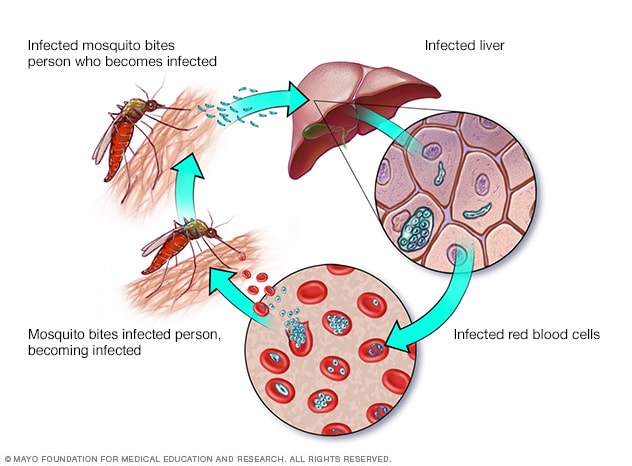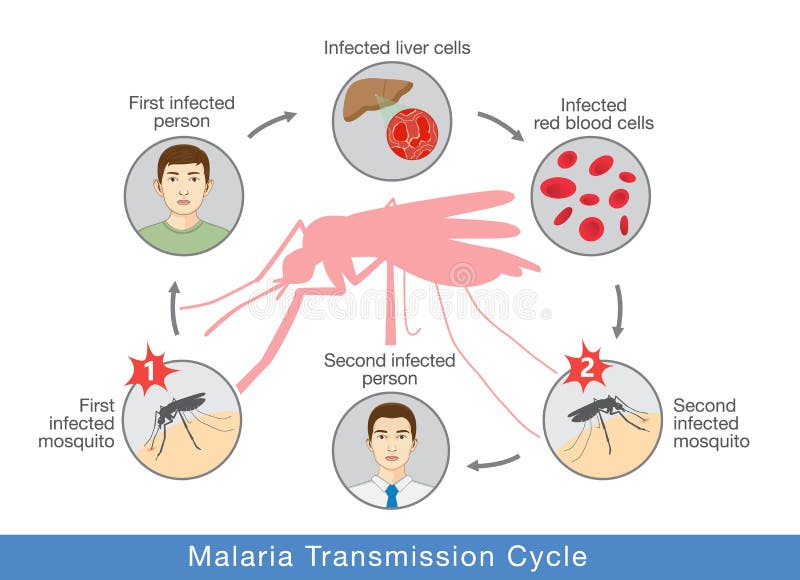Introducton
Malaria is caused by any of the 4 species of plasmodia, that is, plasmodium vivax, p. malariae, p. ovale, and p. falciparum. This is a protozoan infection transmitted by the female anopheles mosquitoes (the vector).
Plasmodium falciparum malaria is severer and sometimes fatal but is readily amenable to treatment while disease caused by the other type is mild and can relapse.
Incubation period: Usually 7-14 days for P. falciparum. May be longer (up to 6 weeks) in people with partial immunity and 12-18 days for the other types.
Life Cycle
Life Cycle in Man
 |
| Photo by mayoclinic.org |
The first phase of the life cycle is in man termed as EXO-Erythrocytic cycle (EEC) which takes 7-11 days depending on the species. At this phase, the parasites (sporozoites) are injected into the blood of man through the bite of anopheles mosquito. The sporozoites invade hepatic cells and multiply into liver schizonts. The liver schizonts rupture releasing plenty of merozoites into the blood.
The second phase in man is called Erythrocytic cycle (EC) and it starts when the merozoites invade or enter Red blood cells (RBC) and initiate that part of the cycle responsible for all the clinical manifestations of the disease.
Life Cycle in the Mosquito
The merozoites in the RBC’s becomes male and female gametocyte. These are then taken up by the mosquito during a bite. The male gametocyte fertilizes the female to produce zygote. The zygote then penetrate the stomach of the mosquito to form a cyst called oocyst. The oocyst contain large number of sporozoits, which then rupture and travel to the salivary glands from where they infect human beings through bite.
Signs and Symptoms
- Sudden attacks of fever (39 - 40°C) accompanied by convulsions in children.
- Chills lasting for 2-4hrs which is then following by sweating (Rigor).
- Headache.
- Nausea and vomiting.
- Myalgia.
- Loss of appetite.
- Joint pains.
Diagnostic Investigations
- Blood smear/film for malaria parasite.
- Rapid Diagnostic test (RDT).
- Clinical manifestation.
Medical Management
- Anti malaria chemotherapy.
- Antesunate + Amodiaquine depending on the strength, give Artesunate 4mg/kg + Amodiaquine 10 mg/kg BID for 3days.
- Arthemether 3.2 mg/kg IM stat then 1.6 mg/kg IM daily for 4days.
- Quinine - in adults and children 10 mg/kg 8hrly IV then change to P.O as soon as possible. Same dosage as in IM.
- Sulfadozinepyrimethanmine (SP). In adults give 3tabs stat. SP is usually used to treat malaria in pregnancy.
- Other drugs include coartem, malafan, A/L (lonart), mefloquine etc.
- Anti pyretics e.g. Tylenol, brufen etc.
- Analgesics e.g. Acetaminophen
- Anti-convulsant for seizure e.g. diazepam, phenorbabital etc.
Nursing Management
- Tepid sponge patient to bring down the temperature.
- The vital signs are evaluated every four hours.
- Give anti-malaria and other drugs as ordered.
- Monitor fluid properly to maintain fluid and electrolyte needs of the patients.
- Look out for the signs of dehydration and administer IV fluids when the need arise.
- Offer small and frequency meal to patient.
- Encourage patient to take copious oral fluids.
- Watch for the onset of cerebral malaria such as confusion, stupor, behavioural disturbances and seizures.
Prevention of malaria
- Avoid mosquito bite by;
- Using mosquito net at night.
- Wearing protective clothing like long sleeve shirts and long trousers at night.
- Using mosquito repellent at night.
- Prevent the breading of mosquito larvae by;
- Always keeping the environment clean.
- Draining all standing waters or pouring oil over stagnant waters.
- Spraying the breeding sites with chemicals.
- Providing proper refuse disposal methods.
- People in endemic area like Africa should take chemoprophylaxis e.g. S.P.
- Prompt treatment of all infected persons.
Complications
- Cerebral malaria.
- Convulsions.
- Coma.
- Anaemia.
Read Also






1 Comments
Insightful article, with causes, symptoms, treatment and prevention. Thank you for sharing this. Glad to discover this blog, keep sharing such helpful and informative articles on health and medicines. As a fellow pharmaceutical company, I am glad to learn this, online pharmaceutical stores have enabled greater availability of medicines, with increased access and often offer better pricing. Buy Tadalafil
ReplyDelete